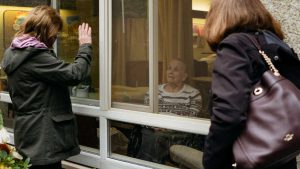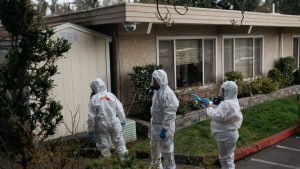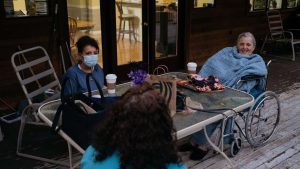OCTOBER 31, 2020

Colleen Mallory and Deanna Williams greet their 89-year-old mother, Peggy Walsh, through the window of Life Care Center in Kirkland, Wash. – Grant Hindsley / NY Times
KIRKLAND, WASHINTON — After months of near-isolation inside his senior care facility, Charlie no longer recognizes his wife of almost 50 years. In another nursing home, Susan’s toenails grew so long that she could not squeeze into her shoes. Ida lost 37 pounds and stopped speaking. Minnie cried and asked God to just take her.
They are among thousands of older people stricken by another epidemic ravaging America’s nursing homes — an outbreak of loneliness, depression and atrophy fueled by the very lockdowns that were imposed to protect them from the coronavirus.
“A slow killer,” said Esther Sarachene, who said she watched her 82-year-old mother, Ida Pasik, wither and fall mute during the months she was confined to her nursing home room in Maryland. “She didn’t know who I was.”
Covid-19 continues to scythe through the halls of long-term care facilities despite an array of safety measures and bans on visitors, put in place months ago to slow the devastation.
More than 87,000 residents and workers have died of the virus, which has infected more than half a million people tied to facilities, and new clusters continue to erupt with numbing regularity: 16 people reported dead this month at a nursing home in Chesterfield, Va.; all 62 residents of a Kansas nursing home infected.
At the same time, the damage of solitude is being overlooked, families and advocacy groups say. They say that widespread lockdowns are still necessary to protect people from the virus, but also that facilities must now confront a growing physical and mental toll of social isolation as the pandemic shows no sign of abating.
Separation from family and friends is among the hardest deprivations of the pandemic. Experts say the absence can inflict particularly serious damage on people with dementia and Alzheimer’s disease, thousands of whom have been confined to their buildings since March.
Operators of long-term care facilities say they are facing an impossible choice between depriving residents of vital human contact and inviting the virus inside.
“We have to walk a very fine line,” said Robin Dale, president of the Washington Health Care Association, a trade group that has noted a recent uptick in virus cases in the state’s facilities amid a new surge nationally. “We need to work toward more in-person visits, but it is difficult right now.”
In more than two dozen interviews across the country, long-term care employees described increased confusion, anger and anxiety among residents. Family members said their relatives were deteriorating in short-staffed facilities that have pared back physical therapy, exercise classes and visits into the community.
One worker described how a resident told her one evening that she was the first person she had seen all day.
“Mom’s just not there,” said Deanna Williams, as she and two siblings headed to the Life Care Center of Kirkland, Wash., to visit their 89-year-old mother, Peggy Walsh, who loved motoring around the country before she developed dementia.

Life Care, in suburban Seattle, was the nation’s first Covid-19 hot spot in February. – Grant Hindsley / NY Times
Life Care, in suburban Seattle, was the nation’s first Covid-19 hot spot in February, a place that gave a first glimpse at how the virus could tear through homes. Forty-six Life Care residents have died.
Since the outbreak, as the deaths of residents of long-term care facilities swelled to account for almost 40 percent of the country’s 229,600 coronavirus deaths, Ms. Walsh has spent each day sitting quietly in her wheelchair, facing the fence and bushes outside her room.
She used to say “I love you” when her children visited and kissed her, but it has now been eight months since they have been able to touch her. Some days, she does not seem to notice when they wave through her bedroom window or dance around with decorative autumn scarecrows to catch her eye.

Forty-six Life Care residents have died in the pandemic. – Grant Hindsley / NY Times
“If we could just give her a hug or a kiss on the cheek,” another daughter, Colleen Mallory, said. “It’s like losing her again and again and again.”
Life Care has continued to operate throughout the pandemic, though families say its population of 200 patients has ebbed. The initial outbreak that killed dozens of residents and sickened much of the staff has now faded, but families say they still get sporadic notifications of a new infection inside.
As Ms. Walsh’s children chatted at a Starbucks before one morning’s visit, their phones suddenly buzzed in unison — it was a text message from Life Care reporting that one patient and three staff members had tested positive.
Life Care Centers of America, which has more than 200 facilities, faces wrongful-death lawsuits from the families of two former Kirkland residents, and federal and state regulators cited lapses in its response to the outbreak.
Life Care has disputed the lawsuits and appealed findings by regulators. In September, an administrative law judge in Washington State sided largely with Life Care, saying that the facility had violated some regulations, but that the evidence did not show that care or residents’ health had been jeopardized.
Nancy Butner, northwest division vice president for Life Care, said the Kirkland facility was doing well and was a top-rate facility. “They are providing a high level of service in a safe environment that ensures peace of mind for our residents and their families,” she said.
All told, the virus has infected more than 581,000 people at some 23,000 long-term care facilities, which include nursing homes, assisted living facilities, memory care centers, retirement communities and other care facilities for older adults.
In the early months of the pandemic, most facilities for older adults banned family and friends from entering their buildings. State and federal regulators issued guidance, restricting visitors and nonessential health care personnel, and canceling communal activities within buildings. In the months since, even as illness and deaths have continued inside some facilities, government restrictions have been eased in many places.

Susan Hailey, right, is trying to recover after five months of isolation. – Grant Hindsley /NY Times
Research groups recently reported that thousands of nursing homes were still facing serious shortages of masks, gowns and other equipment. Adding to the risks, nursing home employees are continuing a long-running practice of working in multiple facilities, increasing the chances they could bring the virus from location to location, particularly if the virus spreads more easily this winter.

A patchwork of state and federal guidelines governs how long-term care facilities are handling visitors. – Grant Hindsley / NY Times
Mark Parkinson, president of the American Health Care Association and National Center for Assisted Living, a trade group, said that despite the efforts of facilities to protect residents, they are in large part at the mercy of their surrounding communities.
For now, a patchwork of state and federal guidelines governs how long-term care facilities are handling visits from family and friends of residents. Some let families inside while many only allow outdoor visits, a dwindling option in colder weather.
Before, relatives could visit to make sure residents finished lunch and had their teeth brushed. A family member’s face and touch can be anchors, experts said, and such a presence helps to engage people’s long-term memories.
“Those familiar faces are what our residents rely on in order to determine whether they are in a safe place or not,” said Dr. Jim Wright, a nursing home medical director in Richmond, Va., who criticized safety conditions at a facility where he used to work, following the deaths of 51 residents in the spring.
Back at the beginning of the pandemic, Charlie Cape could still recognize his wife of 50 years, Linda.
Mr. Cape learned he had Alzheimer’s disease a decade ago and had spent the past two years at a senior care facility in Sarasota, Fla., where Ms. Cape visited him almost every day. A nurse, she would sometimes help feed him, shower him, shave him and periodically give him a pedicure.
His weight was stable, she said, about 180 pounds. He could string together some words. He went to gatherings when they were held on his floor, even dancing with his wife to “My Girl” before the pandemic.
Then the facility stopped allowing visitors.
Ms. Cape said that she tried to talk with her husband using video chats but that the technology was intimidating. He did not understand how the iPad worked and would look elsewhere or get up and walk away. On such calls between March and August, she could see he was losing weight and withdrawing. He no longer takes part in group activities, she said. It has been months since she could understand anything he was saying.
Ms. Cape said she did not blame the facility for banning visitors, adding that she had been impressed with its staff and its communication during the pandemic. The facility, HarborChase, did not respond to interview requests.
“Charlie doesn’t know us any more,” she said in October after seeing him as visits resumed. She and her son go every Sunday with a cookie and a Diet Coke, unless Mr. Cape is sleeping. Sometimes, during these visits, Mr. Cape just sits and cries.
Some of his decline may be attributable to Alzheimer’s, Ms. Cape said, but she believes that the long period of isolation from family accelerated its progress. If nothing else, she feels she missed a crucial period of his life when he still knew who she was.
“I wish that I had had a little bit more time with him, a bit more quality time,” she said. “That’s my regret.”
A survey of 365 people living inside nursing facilities around the country found that most no longer leave their rooms to socialize. Three in four residents said they felt lonely.
Susan Hailey, 77, is trying to recover from five months of isolation. She moved into the Life Care Center of Kirkland to recover from knee surgery but contracted the coronavirus and watched as her roommate and her closest friend at the facility died of the virus. She fell twice and began hallucinating that dead people were visiting her.
“I missed talking to my family and touching them, kissing them on the cheek,” she said.
In August, she moved into a small adult-care home where she has begun learning to walk again. She still has cognitive problems, and cannot read mystery novels anymore because she forgets what happened from one paragraph to the next.
But she says she is happy now, and hopeful, and when her two daughters visited one evening, Ms. Hailey smiled and asked, “Touch me, will ya?”
Courtesy/Source: NY Times










































































































